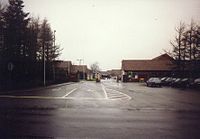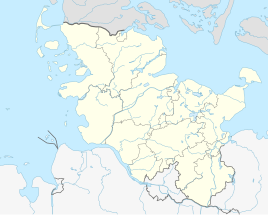Briesen barracks
|
|
|||
|---|---|---|---|

Main entrance (1958–1998) |
|||
| country | Germany | ||
| today | Garden city turnout | ||
| local community | Flensburg | ||
| Coordinates : | 54 ° 46 ' N , 9 ° 23' E | ||
| Opened | 1958 | ||
| owner | Gartenstadt GmbH & Co KG | ||
| Old barracks names | |||
| 1958-1964 | Army barracks Flensburg-West |
|
|
| Formerly stationed units | |||
|
Jäger Battalion 511 Panzerbataillon 513 |
|
||
|
Location of the Briesen barracks in Schleswig-Holstein |
|||
The Briesen barracks (today mostly: Gartenstadt Weiche ) was built in 1956/57 in the Flensburg district of Weiche and in 1958 the first Bundeswehr units moved into it. In parallel, US troops were also stationed in the barracks until the 1990s . The barracks was named after General Kurt von Briesen from 1964 to 1997 . After the barracks were closed in 1997, the barracks buildings were converted into residential buildings and the surrounding area was built on, creating the “Gartenstadt Weiche”, a garden city .
history
The time of military use
In the 19th century, the military training area of the barracks was initially laid out as a parade ground for the Prussian army . The smaller, older parade ground near the Friesischer Berg district was then renamed “Kleine Parzierslücke”, but is now only known for short as Festplatz Exe . Flensburg gradually developed into a military town during the Prussian period . Among other things, the Duburg barracks was built in the north of the city in 1877 and the Flensburg-Mürwik base was built in the east of the city since the beginning of the 20th century , where the military is still based today.
Most of the parade ground in Weiche was used for agriculture by the Jägerslusthof, which the Jewish Wolff family owned from around 1907. When the situation of the Jews in Germany came to a head in the 1930s , Christian Wolff converted the court into a kibbutz . Many later pioneers of today 's Israel did agricultural training there. On the night of the pogrom on November 9, 1938, the SS and police units attacked the court under the orders of Hinrich Möller . Christian Wolff was able to escape to Denmark, from where he emigrated to the USA. His wife and children were deported to a concentration camp in Latvia and murdered there. After 1938 the area was used by the Wehrmacht for the air force and expanded by the Reich Labor Service (RAD) (see Flensburg-Schäferhaus airport ). After the war , refugees were housed there. The RAD buildings were used as the basis for the construction of the barracks from 1956, some of which were retained until 1999 for site management and supply purposes. The area from the Jägerslusthof to Ellund (with the exception of the airfield) was the military training area (TrÜbPl Jägerslust) of the Briesen barracks until 1999 . After the end of the Cold War , the barracks were one of the Bundeswehr locations to be abandoned. This fact was celebrated again on September 6, 1996 with an open house and in 1997 the last units left the barracks.
The barracks were initially called Heereskaserne Flensburg-West after their construction . In 1964 it was named after General of the Infantry Kurt von Briesen (1883–1941). On September 26, 1904, Briesen joined the Emperor Franz Guard Grenadier Regiment No. 2 of the Prussian Army in Berlin as a flag junior and rose to first lieutenant until 1913 . During the First World War he took part in the offensive on the Western Front and achieved the rank of captain . In the Weimar Republic organized the border protection in the province of Pomerania. From 1934 he was reactivated. With its major formation he took in 1940 also at the western campaign in France in part and his division was allowed as a special award for their achievements during the fighting before their commander Lieutenant General von Briesen at the Paris Arc de Triomphe in the capital Paris march past. He was killed in an air raid on November 20, 1941 while traveling to the front near Isjum on the Donets.
Formerly stationed units
The following troops were stationed in the facility until 1997
Bundeswehr (1958-1997)
-
 Panzergrenadierbrigade 16 (H)
Panzergrenadierbrigade 16 (H)
-
 3rd / Supply Battalion 166 (H) (1959–1972)
3rd / Supply Battalion 166 (H) (1959–1972)
-
-
 Telecommunication training company 601 (H) (1993–1997)
Telecommunication training company 601 (H) (1993–1997) -
 Grenadier Battalion 16 (H)
Grenadier Battalion 16 (H) -
 Panzergrenadierbataillon 163 (H)
Panzergrenadierbataillon 163 (H) -
 Rocket Artillery Battalion 650 (H) (1973–1993)
Rocket Artillery Battalion 650 (H) (1973–1993)
-
 Repair Battalion 610
Repair Battalion 610 -
 Homeland Security Command 13 / Homeland Security Brigade 51 (H)
Homeland Security Command 13 / Homeland Security Brigade 51 (H)
-
 Jägerbataillon 381 (H) (until 1981) subsequently
Jägerbataillon 381 (H) (until 1981) subsequently -
 Jägerbataillon 511 (H) (1981–1997)
Jägerbataillon 511 (H) (1981–1997) -
 Panzerbataillon 513 (H)
Panzerbataillon 513 (H) -
 Panzerbataillon 514 (H)
Panzerbataillon 514 (H)
- 1st / Panzerbataillon 514 TE 035 (H)
- 2nd / Panzerbataillon 514 (H)
-
 Jägerregiment 71, formerly HSchRgt 71 (1992? -1996/97?)
Jägerregiment 71, formerly HSchRgt 71 (1992? -1996/97?)
-
-
 Anti-aircraft missile battalion 39 (L)
Anti-aircraft missile battalion 39 (L)
- Staff / anti-aircraft missile battalion 39 (L)
- 2nd / Anti-aircraft missile battalion 39 (L)
- 3rd / Anti-aircraft missile battalion 39 (L)
- Vers./Augabwehrraketenbataillon 39 (L)
- Staff / anti-aircraft missile battalion 39 (L)
-
 Dentist group 101/1
Dentist group 101/1 -
 Telecommunication Company Defense Area (2nd / Command Support Regiment 10)
Telecommunication Company Defense Area (2nd / Command Support Regiment 10) - Security Battalion 610 (na) (1981? -1993?)
US Army (1972-1990)
Conversion of the barracks to the garden city of Weiche

From 1999 the area was transformed into a kind of garden city . The conversion idea of having the Briesen barracks converted into a garden city came from Hermann Stell , who later became mayor of the city. The garden city concept had already found expression in the Friedheim district of Flensburg from 1919 onwards . Some old barracks from the 1950s have been converted into terraced houses. The military training area itself became the foundation land Schäferhaus , which the Bunde Wischen looks after. There are u. a. Galloway cattle bred. The northern part belongs to the parish of Harrislee . There are information boards that deal with the Ice Age or the Ox Trail in more detail. In place of the Jägerslust estate, where the Wolff family lived, three stumbling blocks were laid in front of the memorial plaque to commemorate the three female family members. The path from the garden city (the former access path via the practice area) to the estate is now called Käte-Wolff-Weg . Other parts of the southern area were also extensively rebuilt. The garden city project was completed in May 2015.
Former soldiers' home (today the C.ulturgut venue) near the garden city.
See also
Web links
Individual evidence
- ^ Andreas Oeding, Broder Schwensen, Michael Sturm: Flexikon. 725 aha experiences from Flensburg !. Flensburg 2009, article: Exe
- ↑ Flensburg street names . Society for Flensburg City History, Flensburg 2005, ISBN 3-925856-50-1 , article: Kleine Exe and Zur Exe
- ↑ Gartenstadt: Gartenstadt Weiche is complete , from: May 23, 2016
- ↑ Gartenstadt: Gartenstadt Weiche is complete , from: May 23, 2016
















